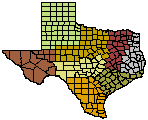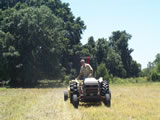- Trans Pecos
- High Plains/Panhandle
- Cross Timbers
- Hill Country
- Post Oak Savannah
- Pineywoods
- Oak Prairie
- South Texas Plains

Wildlife Division District Map
Farmland Management
Cropland, especially those planted with grain sorghum, corn, or wheat can be very beneficial wildlife, especially seed eating birds such as the bobwhite and mourning dove, if managed in a fashion suitable to their needs. Birds such as bobwhites can thrive in cultivated areas where acreage is relatively small, irregular in shape, and is broken up by idle areas. Idle areas such as fencerows, ditches, and field borders that break up vast cultivated acreage's are very important to making the land suitable to bobwhites. Idle areas must consist of native vegetation, such as perennial bunch grasses, seed producing forbs, and brush. Idle areas planted or seeded with exotic grasses, such as bermudagrass are of no value to wildlife. Other practices that will make cultivated land more wildlife friendly include:
1. Leaving a few rows on the outer edge of fields un-harvested.
2. Avoid treating field borders and the outer few rows with chemicals.
3. Reduce field size by leaving 15-30 ft. wide fallow strips throughout.
4. Allow a few fields to lay fallow 1-2 years to provide good brooding habitat.
5. Establish native grasses, forbs, and brush in erodable areas, field borders
and along waterways.
Cost share assistance is available to private landowners through
the USDA's Conservation Reserve Program (CRP), Environmental Quality Incentive
Program (EQIP), and the Texas Parks and Wildlife's Landowner Incentive Program
(LIP) for establishing filter strips, riparian buffers, and grass waterways.
For specific information about Leopold's 5 tools as the Apply to the Post Oak Savannah and Blackland Prairie, please click on the appropriate category below.
Farmland Management
